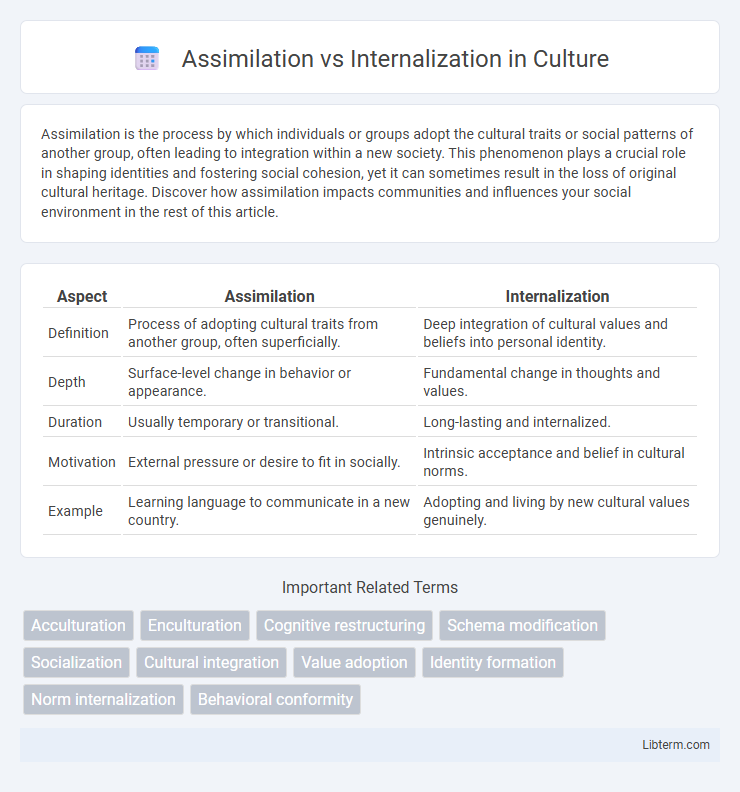Assimilation is the process by which individuals or groups adopt the cultural traits or social patterns of another group, often leading to integration within a new society. This phenomenon plays a crucial role in shaping identities and fostering social cohesion, yet it can sometimes result in the loss of original cultural heritage. Discover how assimilation impacts communities and influences your social environment in the rest of this article.
Table of Comparison
| Aspect | Assimilation | Internalization |
|---|---|---|
| Definition | Process of adopting cultural traits from another group, often superficially. | Deep integration of cultural values and beliefs into personal identity. |
| Depth | Surface-level change in behavior or appearance. | Fundamental change in thoughts and values. |
| Duration | Usually temporary or transitional. | Long-lasting and internalized. |
| Motivation | External pressure or desire to fit in socially. | Intrinsic acceptance and belief in cultural norms. |
| Example | Learning language to communicate in a new country. | Adopting and living by new cultural values genuinely. |
Understanding Assimilation: Definition and Key Concepts
Assimilation refers to the cognitive process by which new information is integrated into existing mental schemas without altering their structure, enabling individuals to interpret experiences based on preexisting knowledge frameworks. It contrasts with internalization, where information is deeply absorbed and transformed, leading to changes in understanding or behavior. Key concepts of assimilation include schema consistency, cognitive equilibrium, and the adaptation mechanisms described in Jean Piaget's theory of cognitive development.
What is Internalization? Core Principles Explained
Internalization is the psychological process through which individuals fully integrate external values, norms, or beliefs into their own identity, making them an inherent part of their behavior and decision-making. Core principles of internalization include genuine acceptance, where the adopted values are sincerely embraced, and enduring influence, ensuring long-term adherence without external enforcement. This process differs from mere assimilation, as internalization leads to intrinsic motivation and self-regulation based on the internalized standards.
Assimilation vs Internalization: Main Differences
Assimilation involves incorporating new information into existing cognitive schemas without changing their structure, while internalization occurs when external knowledge or behaviors become integrated into one's personal value system and identity. Assimilation is a cognitive process primarily linked to learning and adaptation, whereas internalization is a deeper psychological process associated with motivation and self-regulation. Understanding the differences between assimilation and internalization is crucial in educational psychology for designing effective teaching strategies.
Historical Perspectives on Assimilation and Internalization
Historical perspectives on assimilation trace back to early sociological theories that viewed it as a process of minority groups adopting dominant cultural norms, often driven by migration and colonization patterns. Internalization, in contrast, emerged from psychological frameworks emphasizing the adoption of societal values through cognitive and emotional integration, shaping individual identity and behavior. These evolving views highlight assimilation as an external cultural adaptation, while internalization represents a deeper psychological incorporation of norms over time.
Psychological Theories Behind Assimilation
Assimilation, a key concept in Jean Piaget's Cognitive Development Theory, involves integrating new information into existing mental schemas without changing their structure. This process allows individuals to interpret experiences based on prior knowledge, facilitating learning and adaptation. Psychological theories emphasize assimilation as vital for cognitive growth by enabling continuous understanding and categorization of the environment.
Social and Cultural Aspects of Internalization
Internalization in social and cultural contexts involves deeply embedding societal norms, values, and behaviors into an individual's identity, leading to authentic personal adherence rather than mere external compliance. Unlike assimilation, which often requires conformity to a dominant culture and may involve the loss of original cultural identity, internalization fosters genuine acceptance and integration of cultural elements while maintaining individual distinctiveness. This process enhances social cohesion and supports multicultural coexistence by promoting internal commitment to shared cultural principles.
Real-World Examples of Assimilation and Internalization
Assimilation occurs when individuals absorb new information or behaviors by fitting them into existing cognitive frameworks, such as a student integrating new vocabulary into their known language structure during language acquisition. Internalization involves deeply embedding values or norms into one's belief system, exemplified by employees adopting a company's ethical standards as part of their personal code of conduct. Real-world cases show assimilation in children adapting cultural habits from peers, while internalization is evident in activists embracing social justice principles and consistently acting on them.
Factors Influencing Assimilation and Internalization
Factors influencing assimilation include cultural exposure, social environment, and individual adaptability, which shape how new information is absorbed and integrated into existing frameworks. Internalization depends heavily on personal values, motivation, and cognitive engagement, determining the depth at which knowledge or behaviors become part of one's belief system. Both processes are affected by emotional resonance and relevance to prior experiences, impacting long-term retention and behavior change.
Impact on Identity Formation and Group Dynamics
Assimilation involves adopting the dominant group's norms, often leading to the erosion of original cultural identity but facilitating social integration and acceptance. Internalization entails deeply embedding new values into one's self-concept, resulting in a transformed identity that aligns authentically with the group's ethos. Both processes significantly influence group dynamics by affecting cohesion, conformity, and the stability of social identity within multicultural or diverse settings.
Practical Implications for Education and Society
Assimilation in education often leads to surface-level conformity, where students adopt cultural norms without deep understanding, whereas internalization involves genuinely integrating values and knowledge into one's identity, fostering critical thinking and authentic engagement. Practical implications include designing curricula that encourage internalization through reflective practices, dialogue, and experiential learning, promoting long-term retention and social cohesion. Societally, prioritizing internalization over assimilation supports diversity and inclusion by validating individual identities and combating cultural erasure.
Assimilation Infographic

 libterm.com
libterm.com